LG 34UM67: UltraWide FreeSync Review
by Jarred Walton on March 31, 2015 3:00 PM ESTLG 34UM67 Display Uniformity
Given the size of the display, creating good uniformity can be difficult. Most of the display does reasonably well, with the corners tending to vary a bit more the center. The left side of our sample in particular looks a bit dim, but it’s only something you really notice when you look for it.
Starting with white uniformity, the center ends up being close to the brightest area, when most other sectors dropping off slightly. The center portion along with the bottom are all within 10%, which is a good result, but the top left and right corners fall off by up to 15%. Professionals would appreciate better uniformity overall, but for gaming the LG 34UM67 works well.
Black uniformity interestingly is a bit of a reverse from the white, with many areas showing slightly higher black levels than the center. However, our i1 Pro is not the best device for measuring black levels and the actual difference between 0.315 cd/m2 and 0.387 cd/m2 isn’t all the great when looking with your physical eyes, even though it’s a 23% difference. There’s a lot of variability in the charts, but mostly the corners seem to be the biggest outliers.
Compared to our earlier calibrated results, or uniformity contrast measurements have all fallen off quite a bit. Our measured contrast this time ranges from 465:1 on the bottom-right corner to as high as 662:1 just above the center, but I think most of the black levels were measured too high so the contrast results are only moderately useful.
Delta E shows similar uniformity again. The top-left edge and top-right seem to have the greatest variance, but for a non-professional display most of this discussion is academic.
The short summary is that uniformity on the LG 34UM67 is good but not exceptional. There will obviously be differences between panels, so where we had problems primarily on the corners and left/right edges, other displays may show more or less issues. Perhaps the most telling aspect is that prior to testing uniformity, I looked carefully over the display with a variety of solid background images to see if I could detect any problems. There are some very minor discolorations that show up primarily when viewing pure white, but the size of the display makes the corners more of an acute viewing angle so it often feels like that’s as big of a problem as display uniformity.


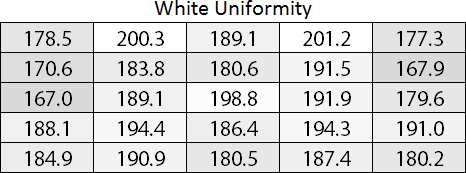
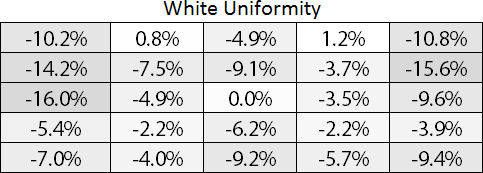
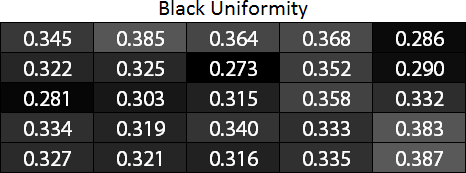
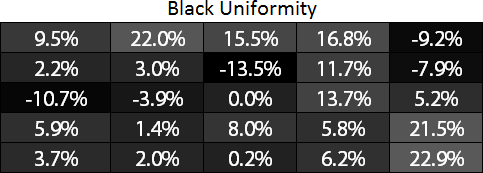
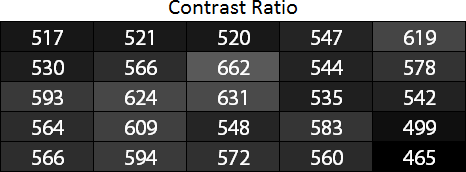
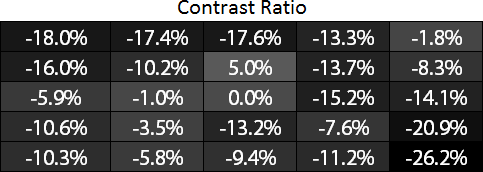
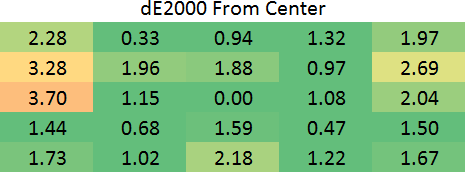








96 Comments
View All Comments
inighthawki - Tuesday, March 31, 2015 - link
You guys really need to get the hardware for measuring input lag. For most displays this would not be a big deal to not know, since most are reasonable for basic activities. But when reviewing a gaming display, this is a pretty critical thing to know.Eidigean - Tuesday, March 31, 2015 - link
I completely agree, input lag is very important. I still use my ZR30w IPS display which does not have a scaler or OSD, and the input lag is much lower than the Dell U3011.From Brian Klug's review...
http://www.anandtech.com/show/4070/dell-u3011-revi...
The U3011's scaler / OSD added 12ms of latency compared to the XR30w.
Souka - Tuesday, April 7, 2015 - link
I game on a 24" Sony CRT computer monitor.... my lag is in nano-seconds. :)(Well, many years ago I was using one)
Kinda miss those screens
willis936 - Tuesday, March 31, 2015 - link
Honestly. It's months overdue. It's arguably one of the most important things to !measure on any display, let alone ones with gamer oriented features (cutting edge adaptive sync technologies).jimjamjamie - Wednesday, April 1, 2015 - link
I'll even disable uBlock for a few weeks to help raise funds.Byte - Thursday, April 2, 2015 - link
Darn almost peed my pants then saw it was only 1080. Was kinda surprised when i saw DP 1.2a and HDMI 1.3 but that explained it. Give us 1440 curved with freesync and its probably pinnacle for easily 5 years till OLEDs take over.okashira - Thursday, April 2, 2015 - link
I would have been embarrassed to post any kind of FreeSync or FreeSync vs Gsync review without exact input lag numbers.blanarahul - Tuesday, March 31, 2015 - link
*sniff* *sniff* Nobody cares about the high contrast ratio VA panels.MrCommunistGen - Tuesday, March 31, 2015 - link
I'd love to pick up a G-Sync or Freesync version of the BenQ BL3200PT if they could pull off even a slightly wider range of refresh rates than we see here in this review. 40Hz to 80Hz would allow them to double strobe every frame at 40Hz or below.Samus - Wednesday, April 1, 2015 - link
Interestingly, what I take away from this review, is AMD screwed up one of the benefits of G-sync, that is, the range of refresh. Even though this monitor is capped at 75hz, ie 75FPS, even with vsync off it should know better than to drop below 60FPS/60HZ because tearing is more annoying than judder at lower FPS because the tearing stays on the screen longer since the refresh rate is lower. That's a real oversight...Personally I just stick with 144hz panels (all of which are TN unfortunately) and always have vsync on. With a powerful enough card that never drops below 60+fps it is butter smooth and looks smooth as butter.